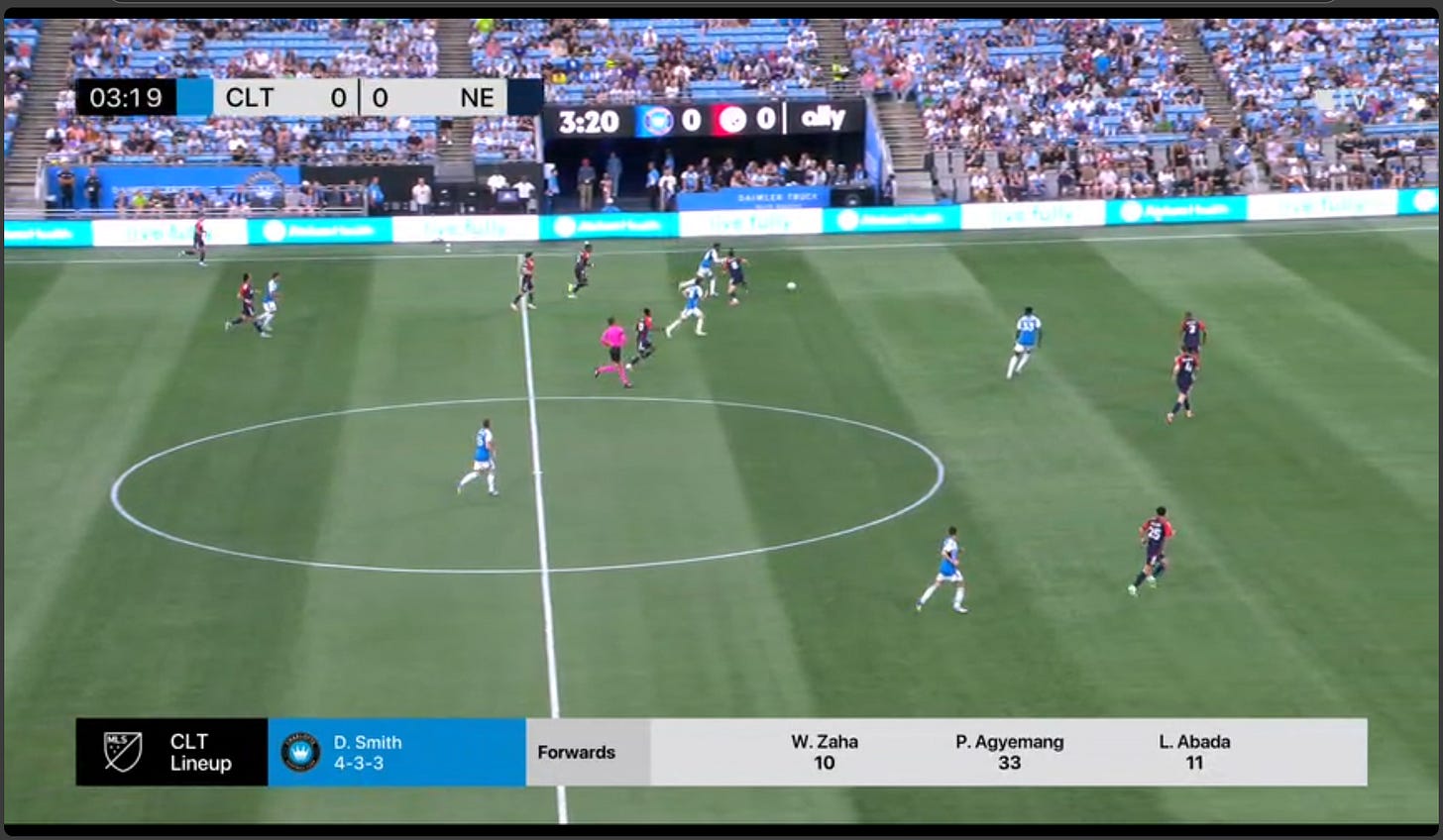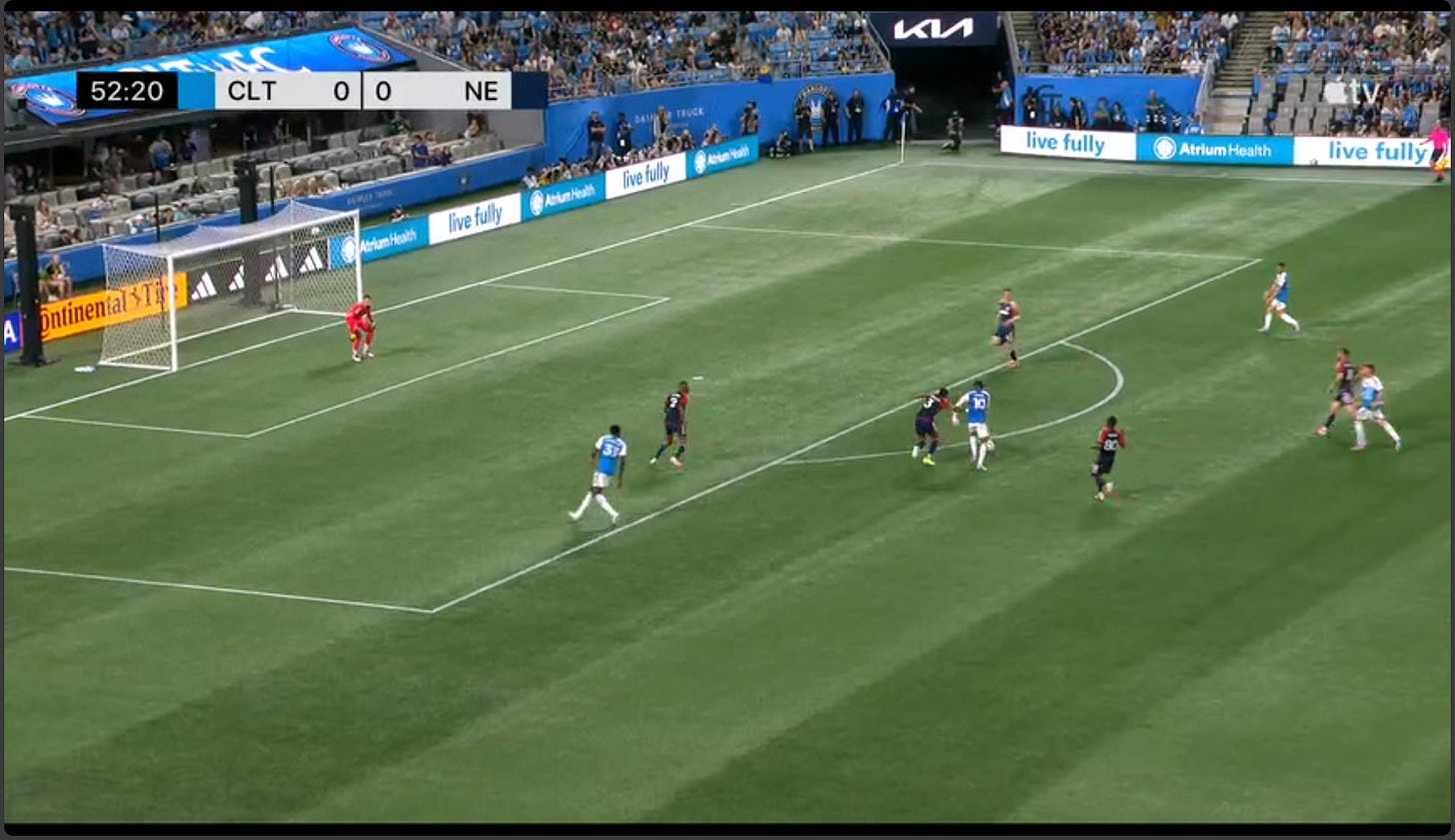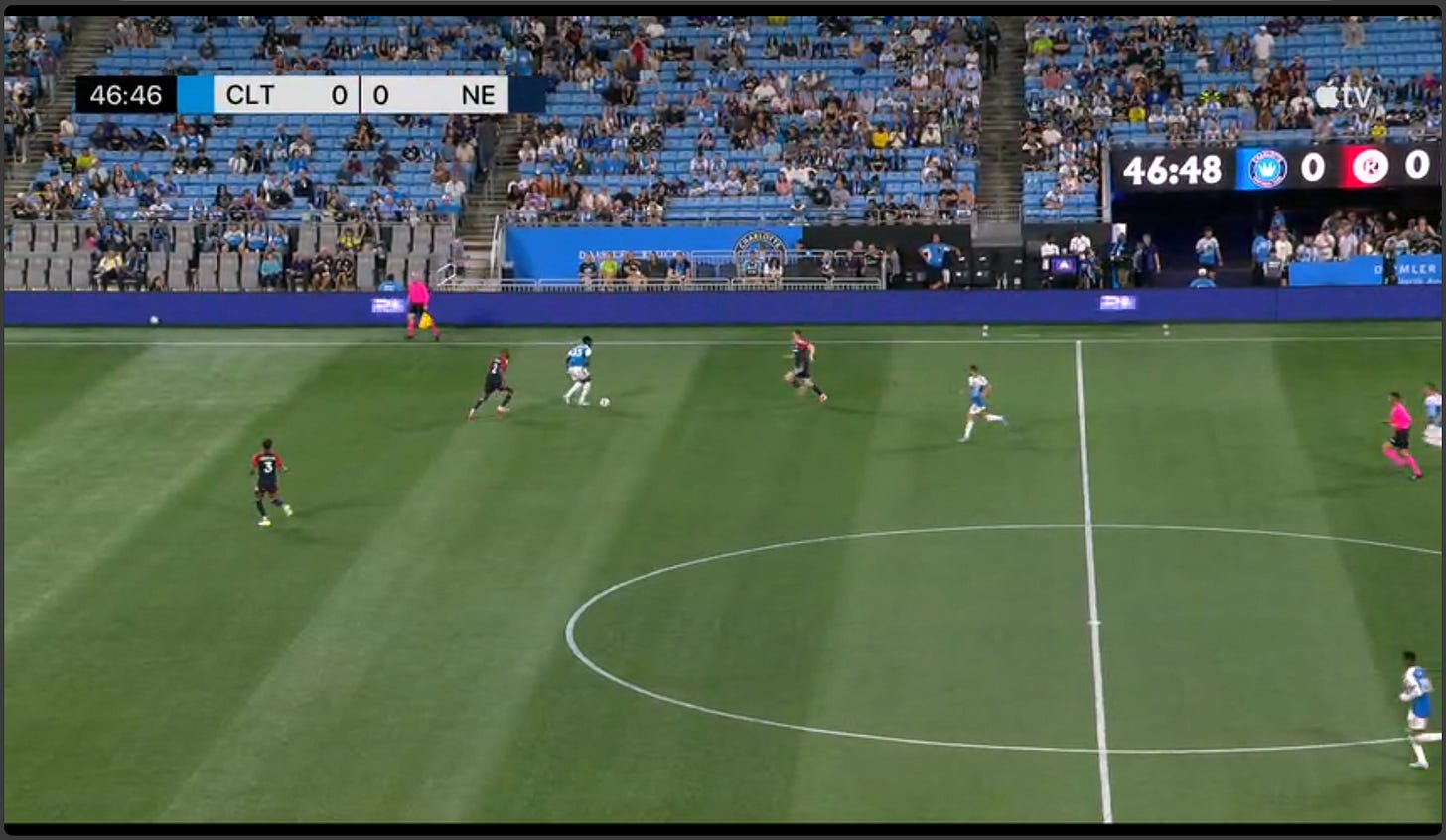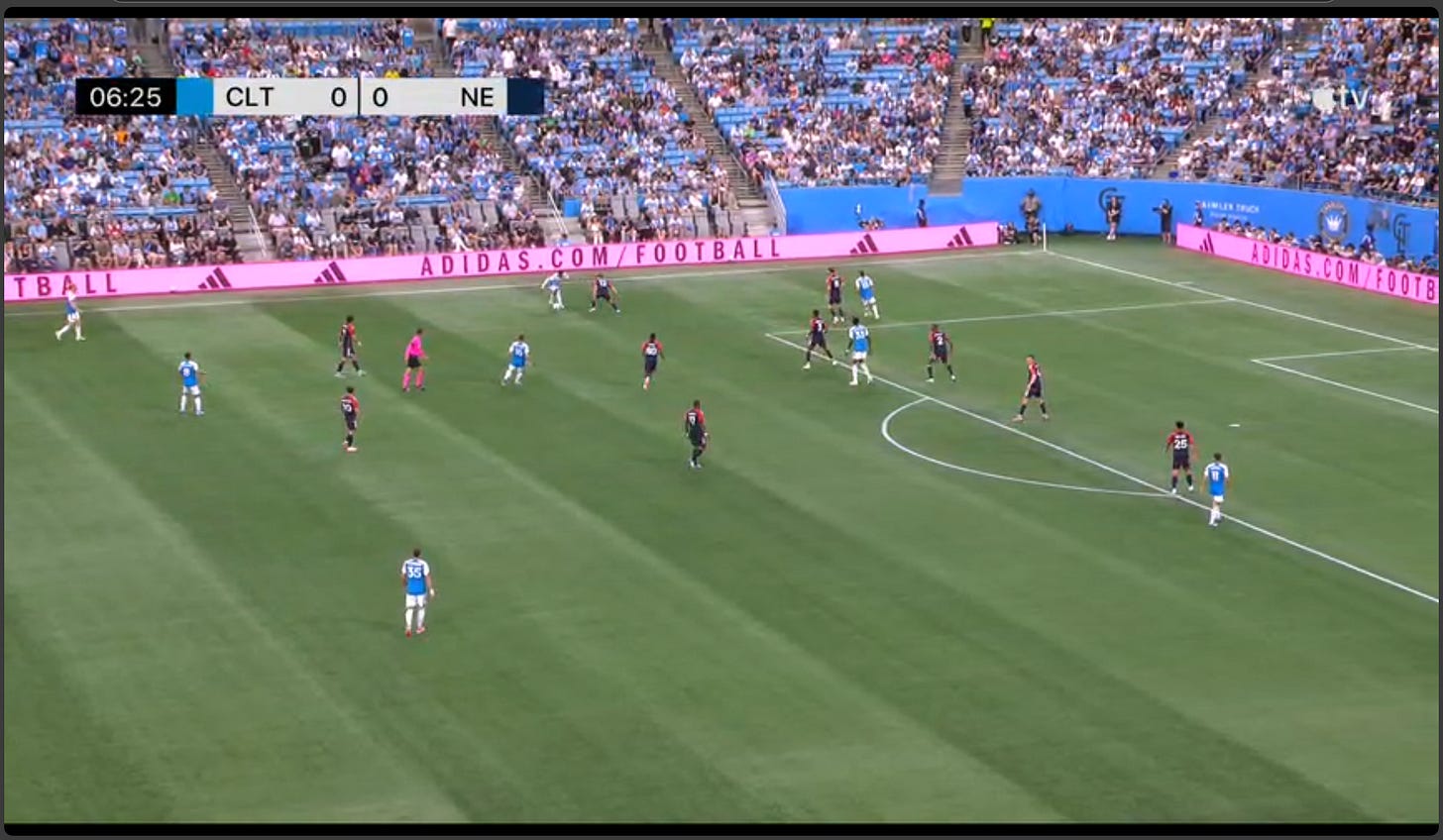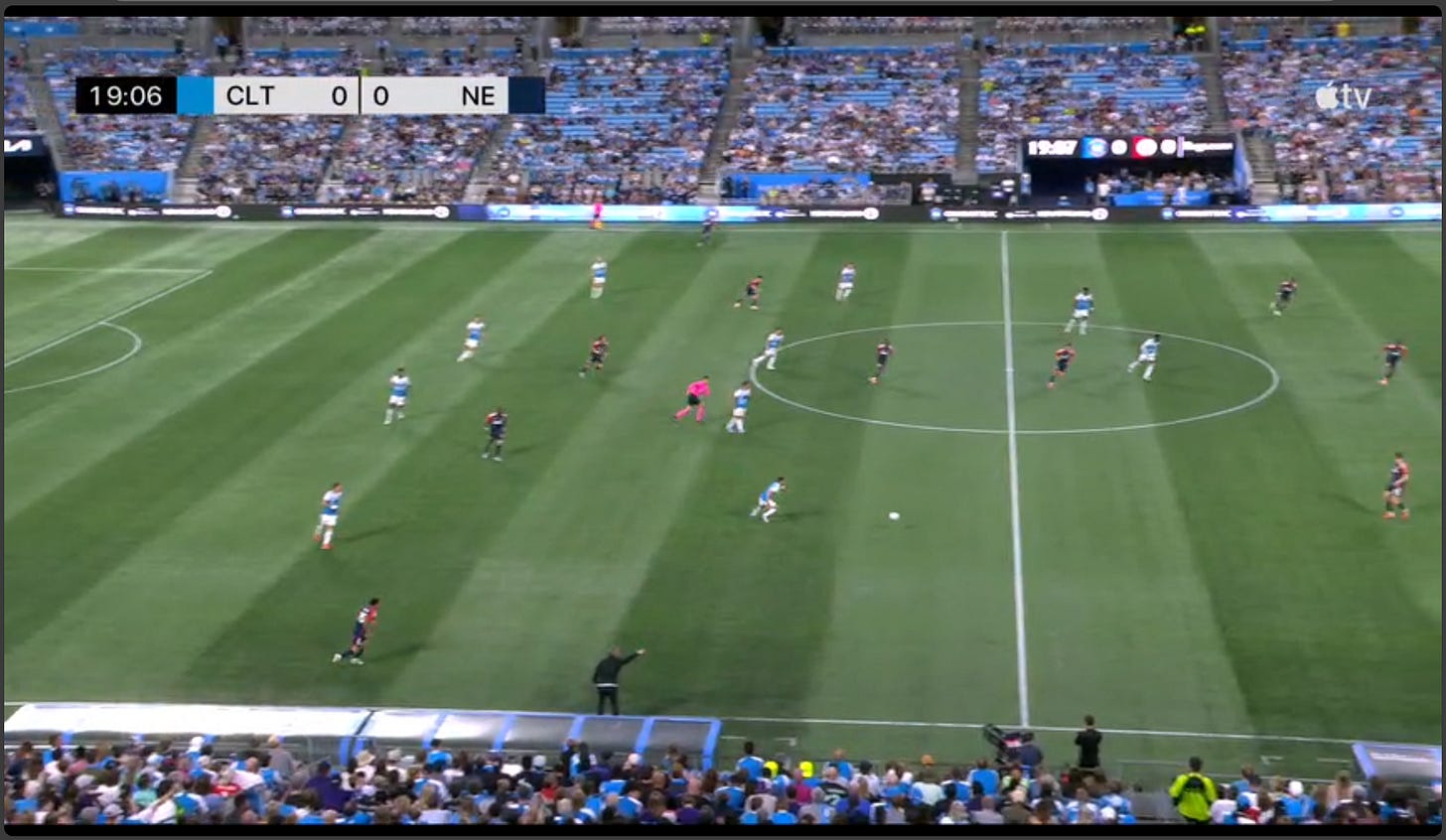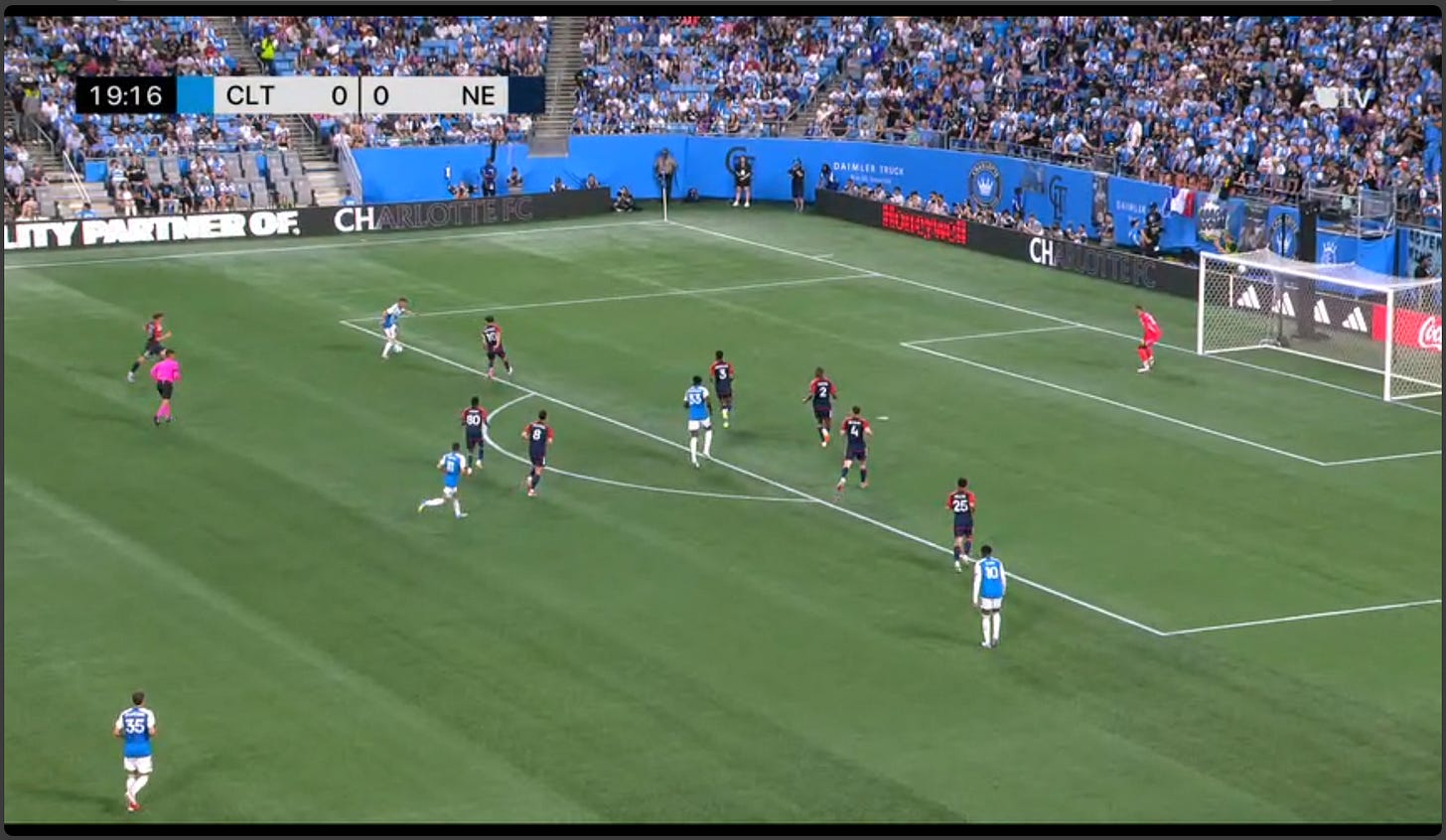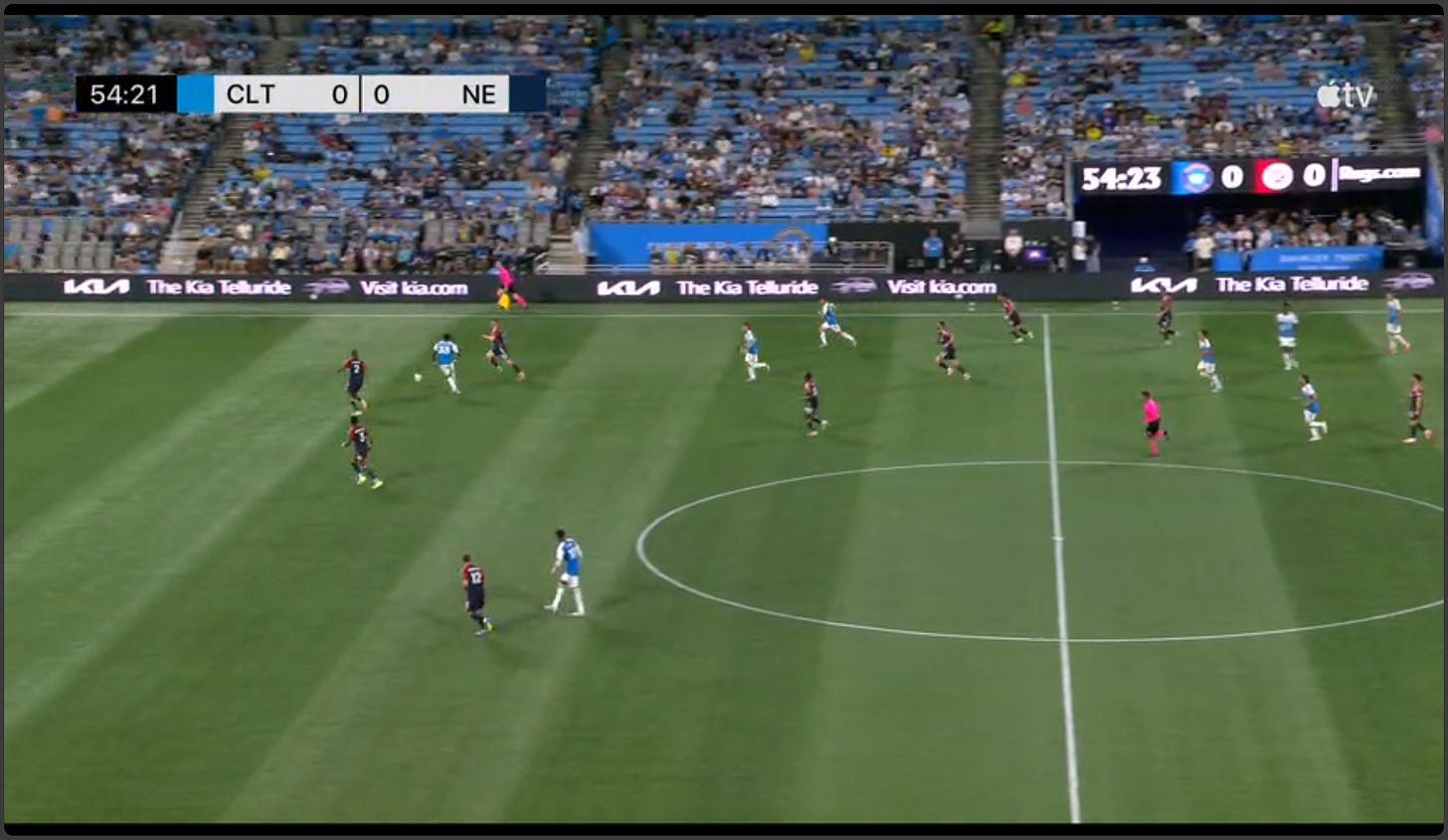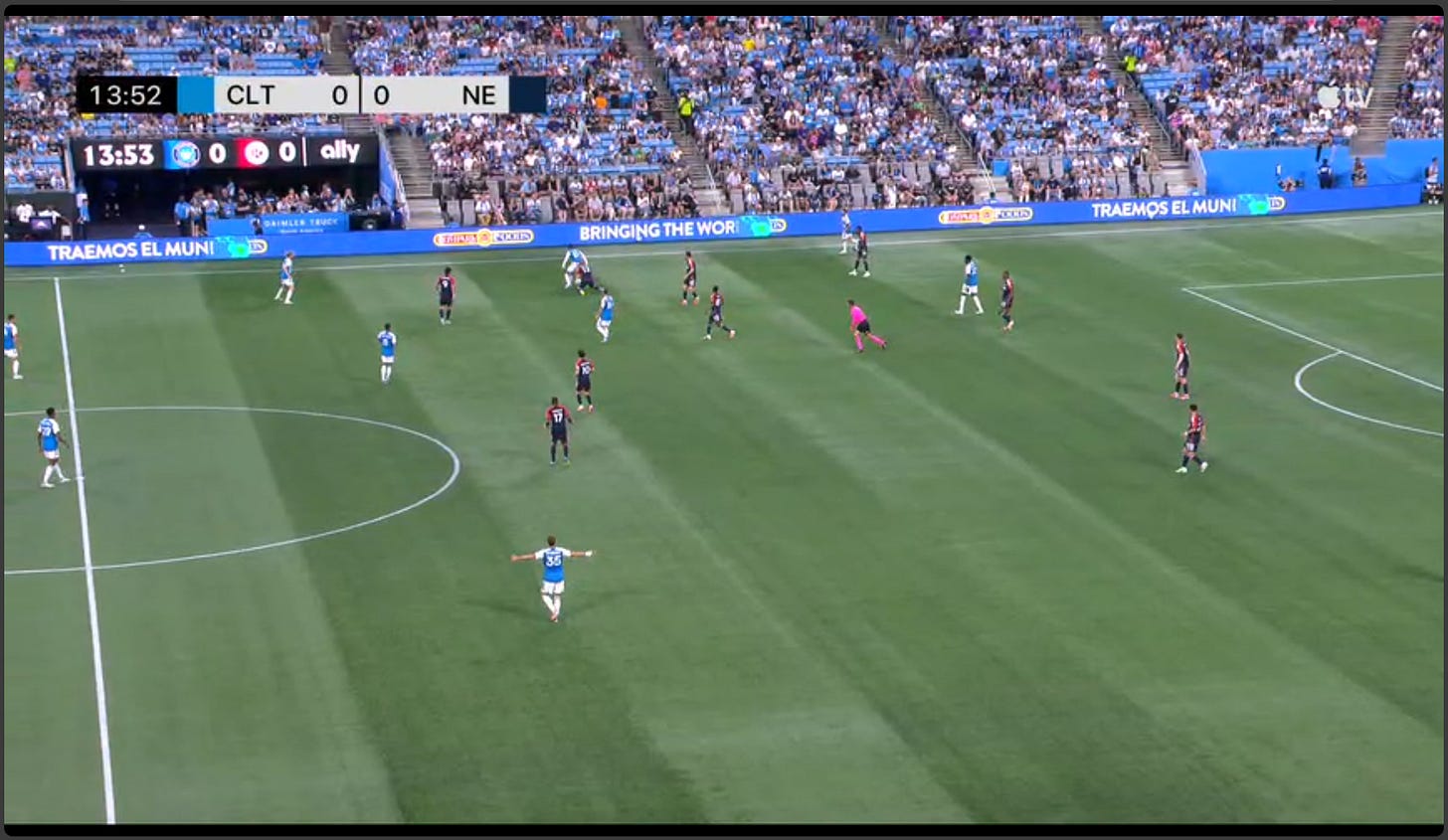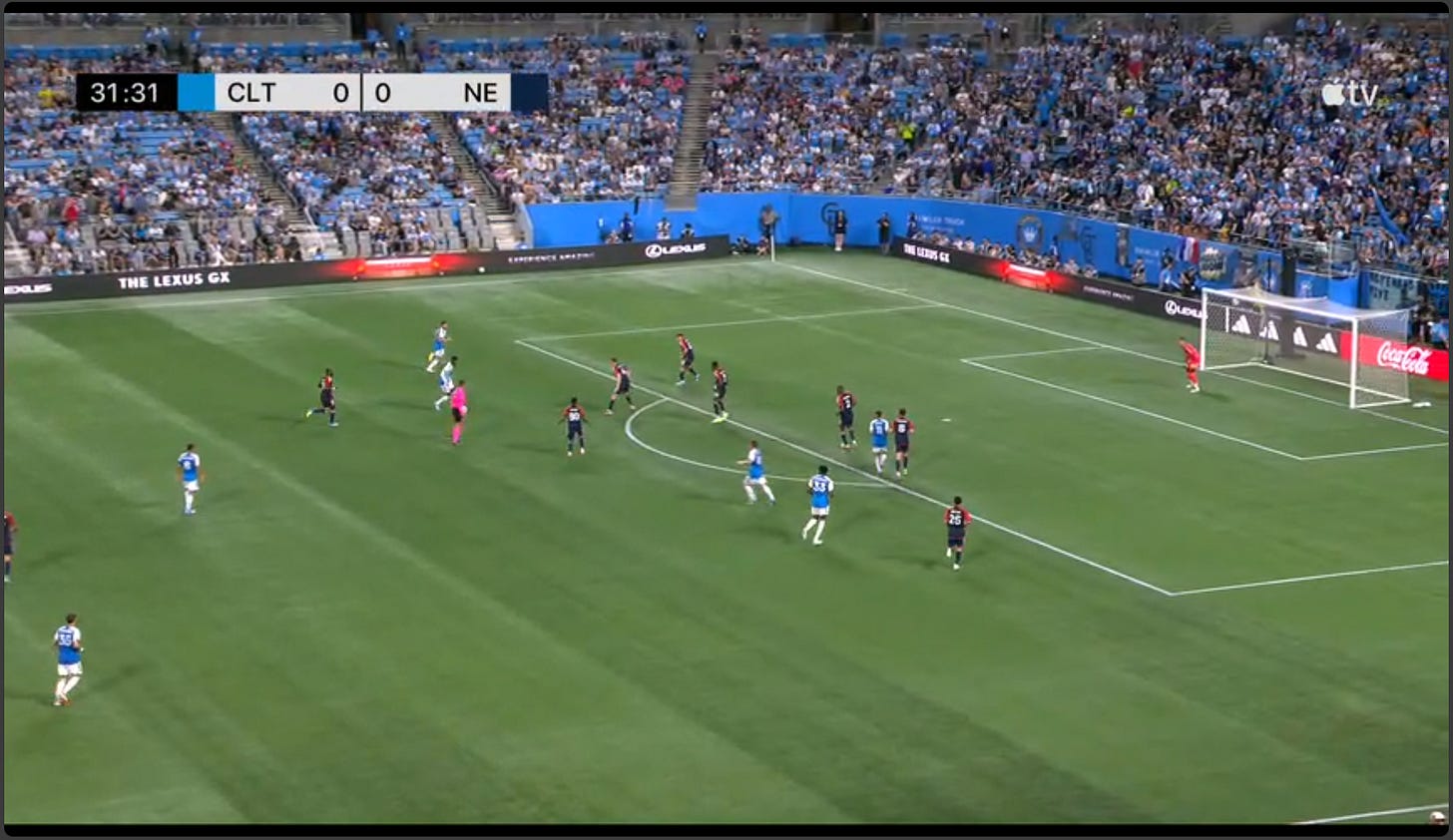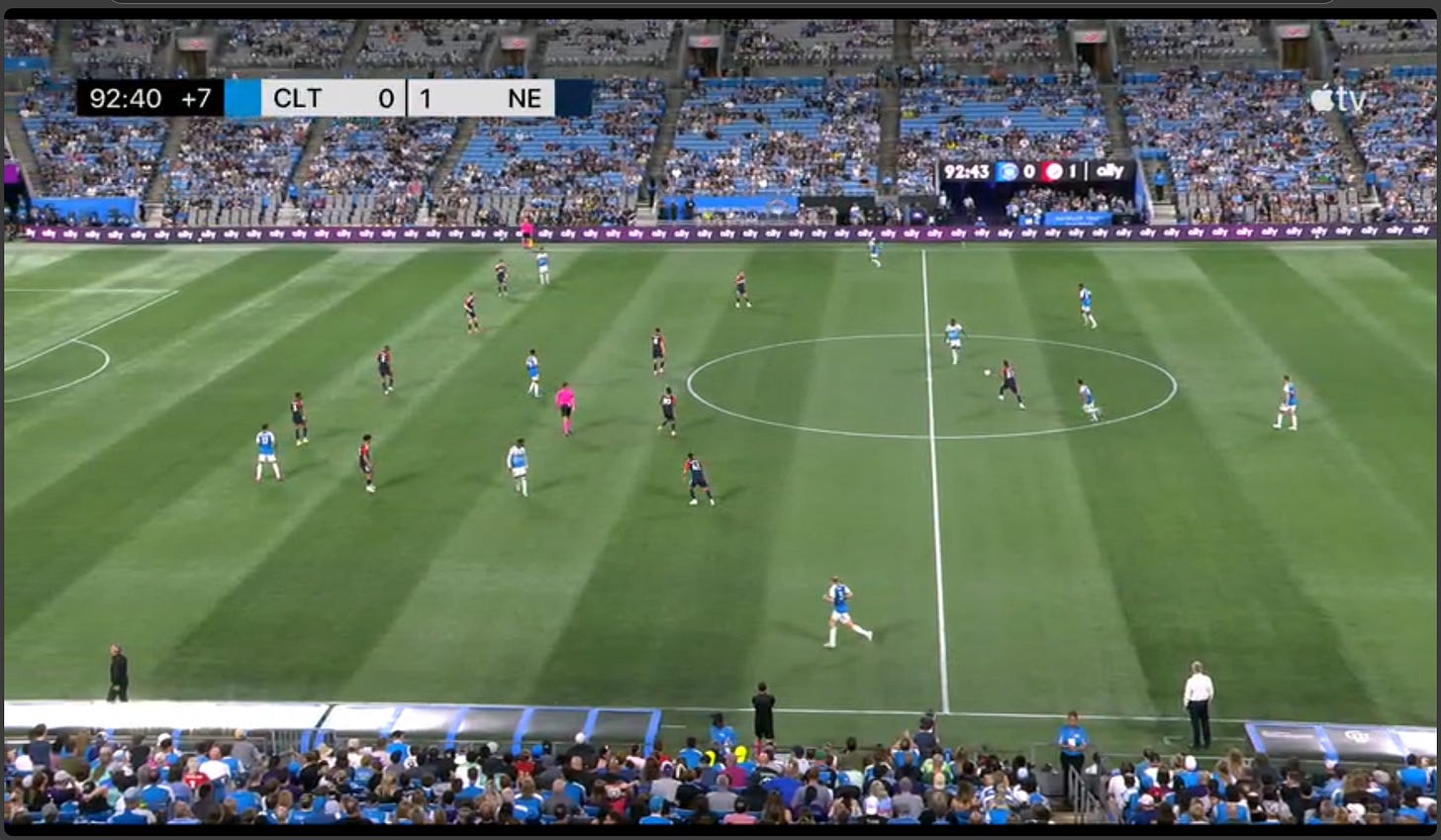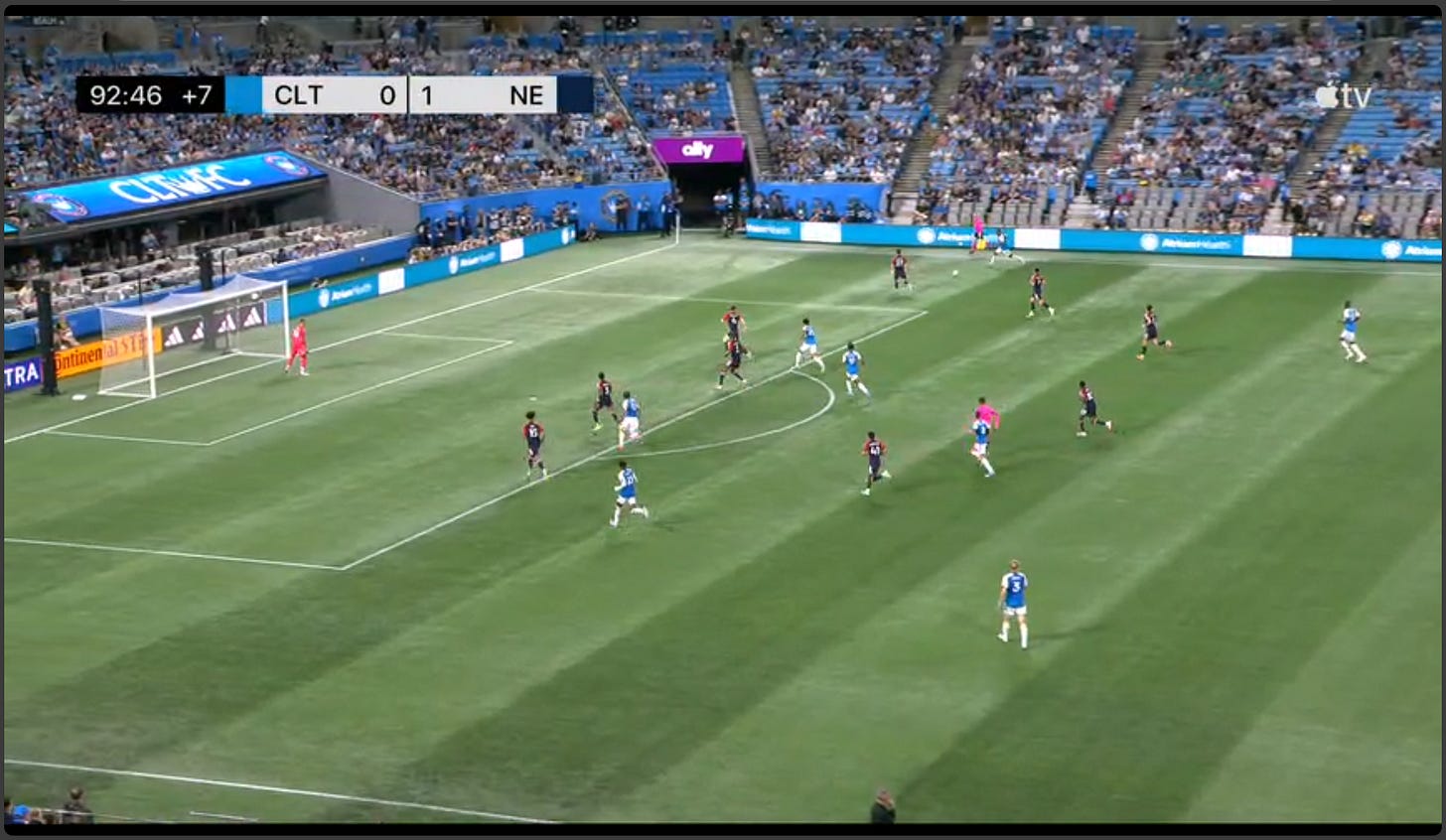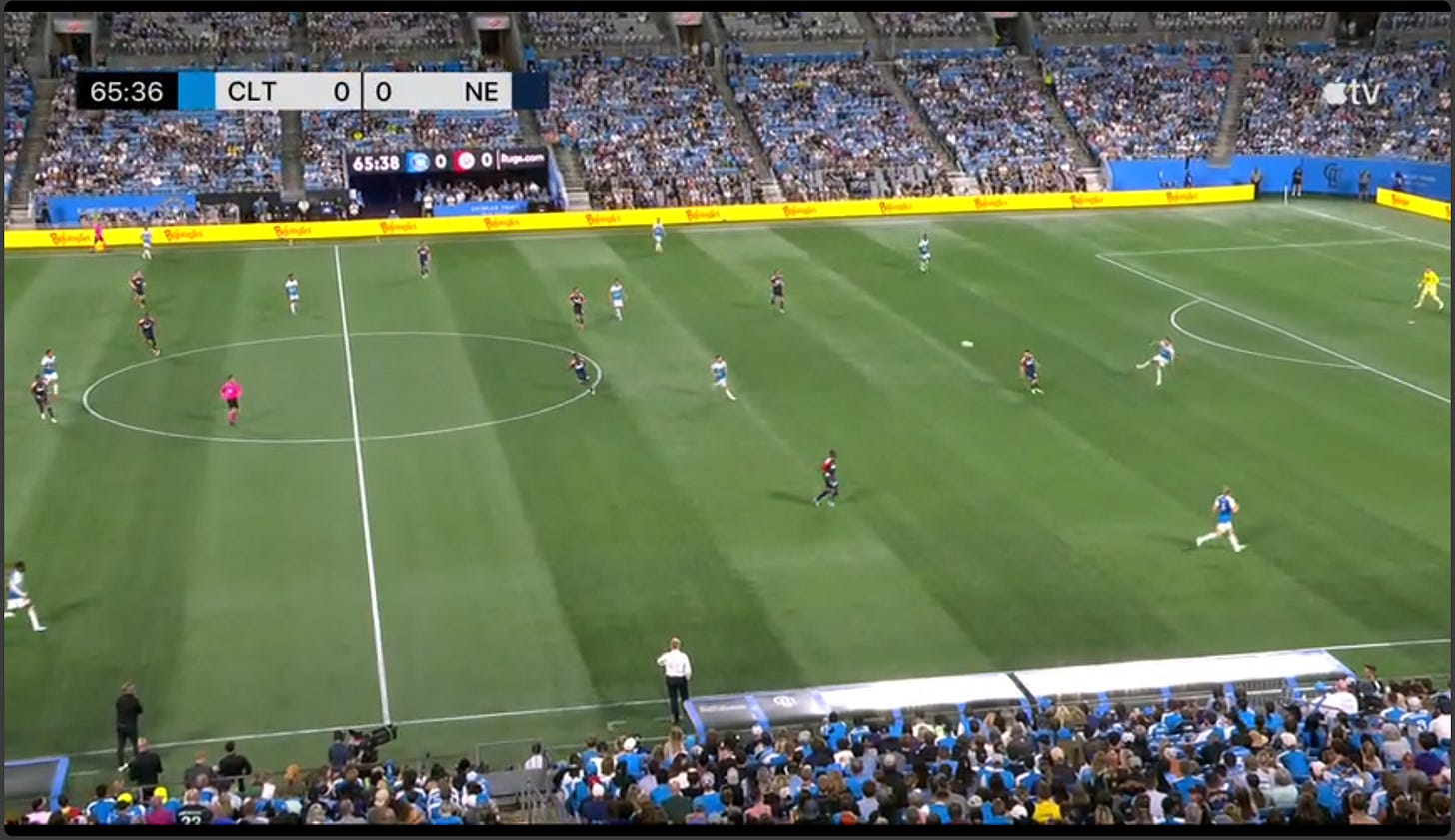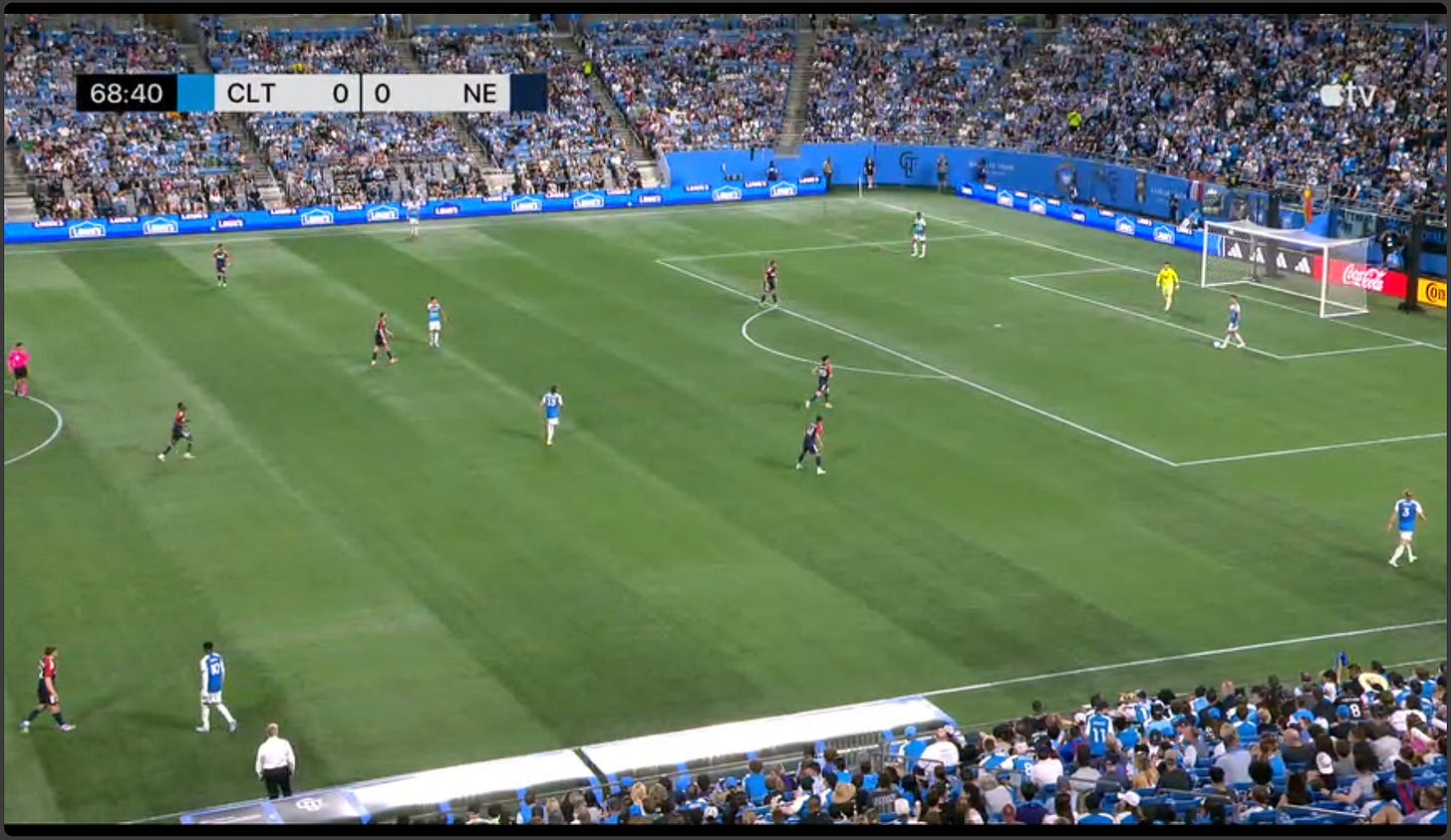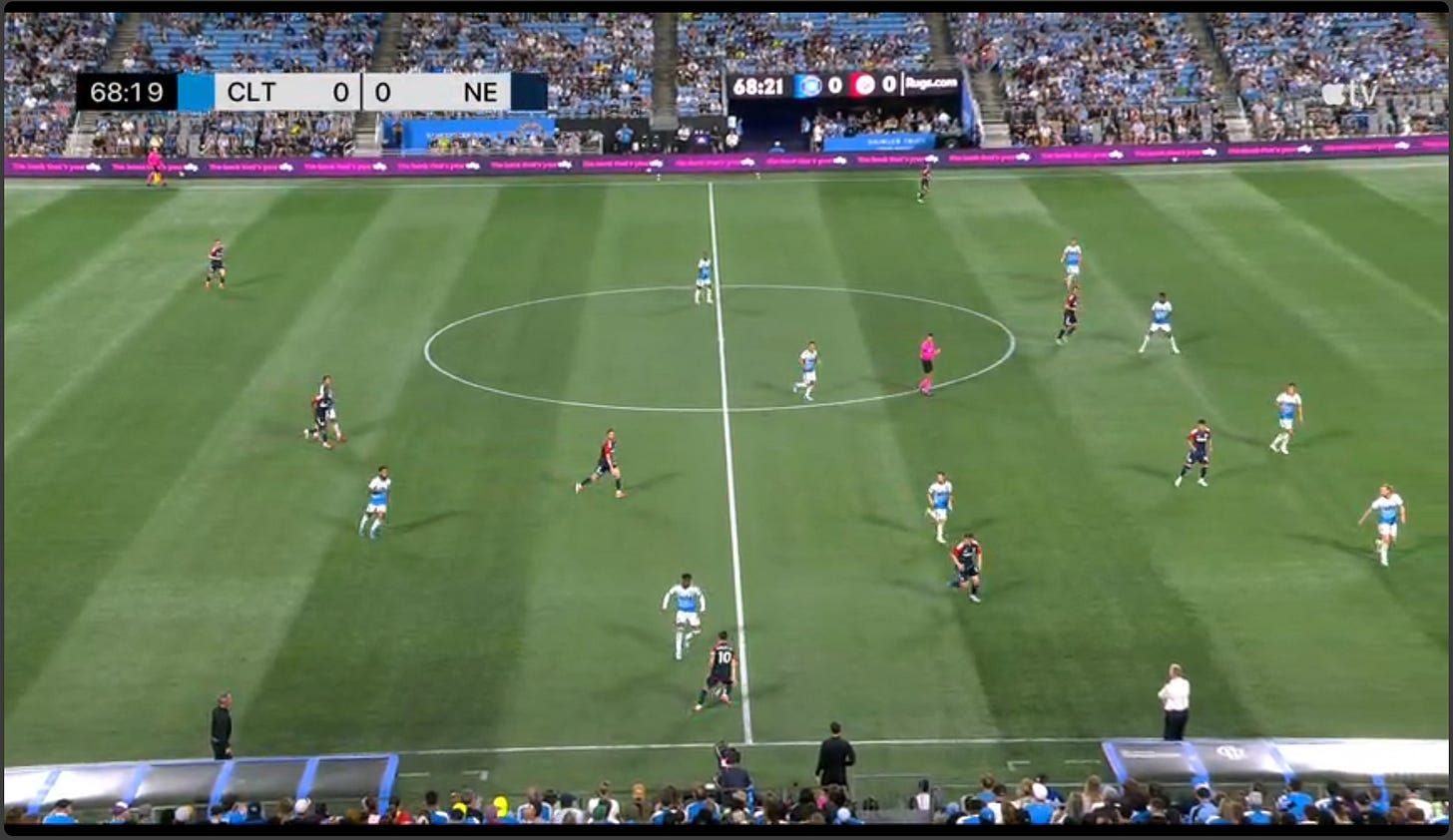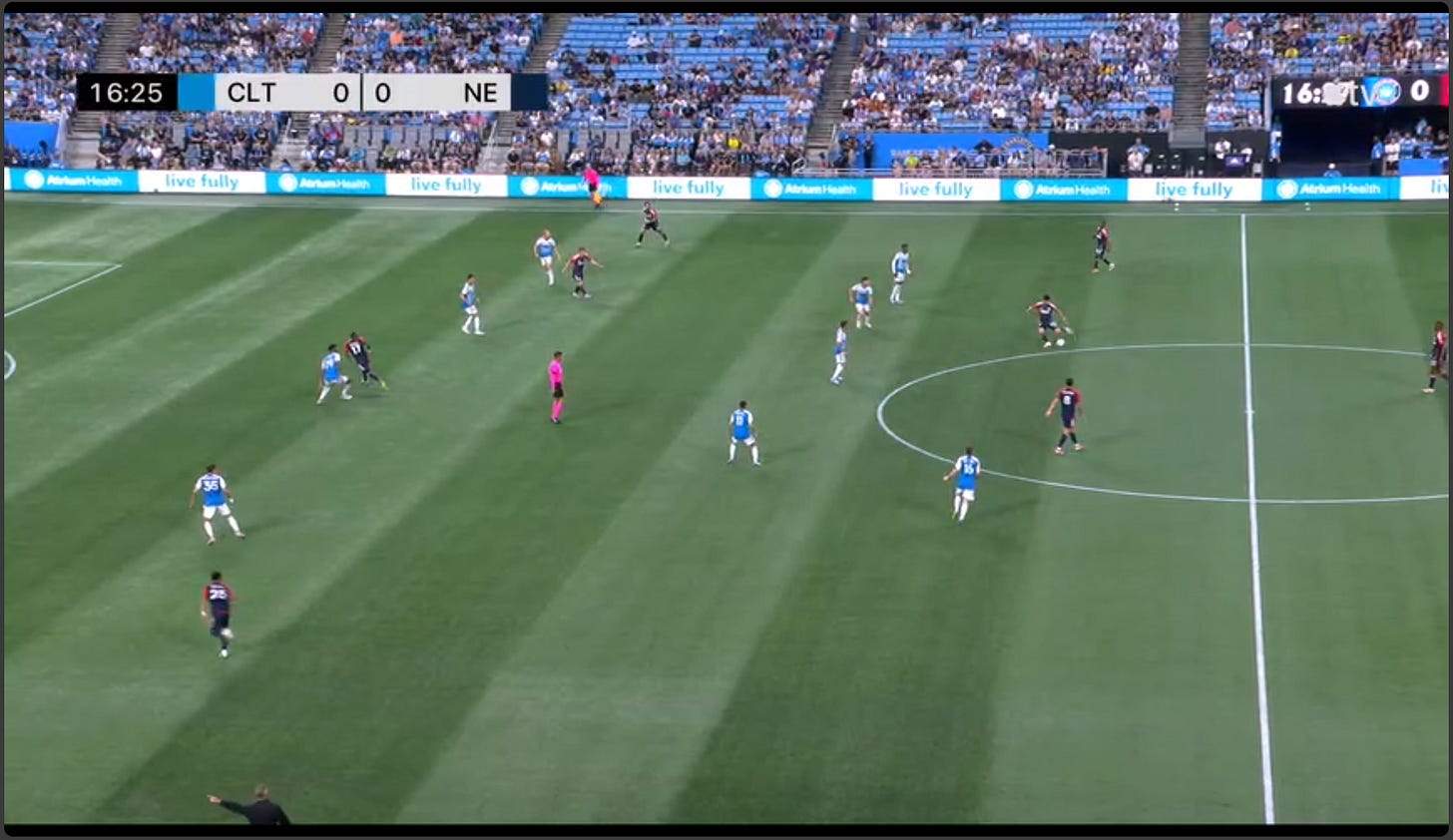Film from the Fortress: CLTFC vs New England Match Review
A deep look at Charlotte's skill vs situation and how we can avoid these types of losses in the future.
It always disappointing to see a win streak come to an end, especially in a game where the loss feels harsh. Charlotte FC was the better team this weekend against New England Revolution. Had we taken a few chances and gotten an offside call to disallow the goal Charlotte could have had all 3 points. But we miss a big insight if we just dismiss this game as CLT being “unlucky.”
Charlotte has more skill both on paper and on the pitch. But New England created a game situation that gave them a chance to win. They sacrificed some attacking threat by playing long balls and build up out wide to avoid costly turnovers in CLT’s mid-block defense. And they were conservative attacking, keeping defenders back to ensure CLT could not attack with a numbers advantage.
We have struggled this season against less skilled teams that have played like New England, such as Colorado and Nashville. On the opposite end, teams that play to a situation that benefits us (Cincinnati, San Jose, and San Diego) we have crushed. As we go through this game review, I want to focus on how we can adapt our gameplan and mentality against teams that play like New England, so we do not just have to rely on our skill but can also make the situation more favorable.
Topic 1: Transition Attacks
Charlotte is really good and attacking in transition and that was evident this game. While we attack in transition plenty, I’d argue we need to do it even more. Opposing teams can try to limit the amount of transition attacks we have. With how dangerous we are in transition and the fact there are limited opportunities to attack in transition, we need to value every chance we can to push the pace in transition.
First let’s define a transition attack. For a working definition, it is an attack that occurs within (approximately) the first 20 seconds after gaining live-ball possession. Generally, these chances are when a defense is not set, opposing players are too far forward, and there is space in behind to attack. A great transition attack is defined by rapid and direct ball progression toward the opposing goal.
Let’s explain transition attack further with this example, our best chance created in the first half. Campana tries to make a long pass out wide but it goes straight to Scardina, causing a change in possession.
We’ve just won possession and Scardina passes forward to Abada who immediately started moving forward on the turnover.
Abada takes one heavy dribble out then plays a through ball past his man into Biel. As Biel runs onto the ball he does a one-touch outside the boot pass to Agyemang.
Now everything so far has been towards goal. Agyemang receives this ball with his back to goal though. After taking a touch, he plays it back to Biel quickly maintaining the speed of the attack.
As New England defenders try to gain their shape, they fail to mark Zaha on the far side. Biel makes a one touch lofted pass into Zaha who is clean through on goal.
Yes, Zaha takes a poor first touch and then the shot is saved. But let’s look at the pace, distance and directness of this attack. From Scardina getting the ball halfway in our own half to Zaha receives the ball 12 yards from goal takes only 12 seconds and 8 total touches.
Transitions put our players in low risk, high payoff situations
Transition attacks provide a situation where our players can try to use their top skills in a low risk, high payoff opportunity. In the examples below, you’ll see risky passes and players looking to take on and beat a defender off the dribble. If they lose the ball the risk is low, our defense is still set and the other team gets the ball far away from our goal. But if the pass or take on works then we have a premium goal scoring chance.
For example, Agyemang’s dribbling and pace shine in transition. Here Bronico just counter-pressed and made a clean tackle winning the ball.
Bronico takes 2 dribbles forward and then passes into Agyemang who is outside of New England’s far side center back. Agyemang receives the ball, faces the center back and then immediately cuts down the sideline.
If you can watch this clip as a video. From here Agyemang does a quick stop and go and puts center back on the floor and he dribbles into the box. He tries a nice cutback pass to Biel that unfortunately gets intercepted.
This sequence (and a similar one 2 minutes later) is a situation for Agyemang to show his skill to create a dangerous chance. Agyemang gets a chance to take on the center back and when he beats him has an amazing cutback opportunity.
This same situation of freedom to take on defenders off the dribble in possession benefits Zaha. Here possession goes back and forth until Bronico taps it back to Zaha (top of screen) who starts to dribble forward.
It is clear Zaha wants to attack and quickly. He first picks his head to look for runners and a through ball. He then dribbles forward and looks to take on their right back.
He beats his defender with one touch and the whole sideline is open for him. He carries all the way into the box and has some dangerous options.
Above Zaha could try to drive a near post cross to Agyemang, he can try to dribble his defender or try a cutback pass to Bronico/Biel. His cutback gets blocked but by using his dribbling skill in transition Zaha has created a great scoring opportunity.
Unlike when a defense is set, in transition Zaha usually only has to face and beat one defender to create a chance. Here in the second half a clearance is poorly dealt with by New England and it falls to Zaha.
Zaha smartly carries the ball forward and he doesn’t get pressured until he gets to the edge of the box. Zaha has one defender on him and cuts onto his right beating his man easily. Also note its only 5 seconds between the clips above and below.
Now Zaha could shoot from here but he draws the far side center back inside to cover him. So Zaha plays Abada through who gets an open shot and unfortunately flubs it.
Transition attacks also provide this low risk, high reward situation for our progressive passers. In transition, Ashley Westwood can receive the ball facing forward without pressure and runners available to pick out his trademark long passes.
Here we win the ball in the defense and Scardina just clears it. Agyemang does a great job tracking it down and beating their center back to the ball.
Now Agyemang does not directly move the ball forward and instead lays it back to Westwood. Now usually this would not be ideal for a transition attack but it works here because of Westwood’s playmaking ability and willingness to make a risky pass. Westwood receives this ball facing forward with space. He does not slow down the play and instead takes this pass first time and swings a long ball out to Zaha.
The ball falls directly to Zaha who carries it toward the box, draws a double team then tries to pick out a pass to Abada or Biel running into the box.
Zaha misses this pass, but if he gets some curve on the ball this could fall into the run of Abada or Biel for an easy tap in. Again, despite the backwards pass we’ve moved the ball essentially from our box (Scardina’s clearance) to their box in 10 seconds. Attacking in transition creates situations for Westwood’s quality as a passer to shine.
Placing higher value on every opportunity to attack in transition
The drawback of transition attacks is they require a live ball turnover to be possible. Opposing teams can take actions to limit the amount of transition opportunities they concede in a game. With this in mind, CLT should value any opportunity to attack in transition at a premium. Building a mindset of going quick and direct off every turnover possible will improve our situation in games. The previous examples showed the danger we pose in transition, these next examples show opportunities we turned down.
Here Abada pressures their midfielder and he makes a poor pass across the field allowing Zaha to run onto the ball off a turnover.
Zaha has to track this down then turn and it is a 4 on 5. So Zaha stands on the ball then cycles back to Bronico instead of dribbling forward to take on a defender.
So we cycle the ball around our defense and 15 seconds later Zaha gets the ball in a similar spot and takes on his man. But now he is dribbling at a wide midfielder and not their defender.
In this scenario Zaha gets doubled team as he cuts inside and we lose possession. While the transition attack opportunity did not look promising, it was a better opportunity than what we got after letting their defense reset. By not looking to attack in transition, Zaha put himself in a tougher situation to create a scoring chance.
Let’s look at another lost transition chance this time from the right wing. Here New England’s center back makes a poor pass trying for their wide player and it falls straight to Abada.
This looks like a great chance in transition, but we fail to push this transition. Instead of Abada trying take on a defender or Zaha/Agyemang making a quick run into the space behind, Abada just carries forward slowly.
We get the situation above where there is not anything creative going on here and with 5 second already elapsed we are losing that transition attack window. Abada does cut onto his left and find Biel at the top of the box, but Biel has a defender in front of him and eventually has to dribble and recycle the ball through our defense.
Sometimes we lose transition opportunities by the player on the ball being slow, and sometimes it is from a lack of off ball runs. Below, Kahlina claims a cross and quickly rolls it out to Abada who squares it across to Westwood. Like the earlier example, Westwood is facing forward with time on the ball.
There are two opportunities missed here. First, Zaha is open and Westwood does not play the ball (he winds up passing out to Abada who will recycle to our defense). Second is Agyemang is standing in the center with his hands gesturing to slow down the pace. He has a chance here for our best long ball passer to play him through one on one against a center back. Agyemang’s eyes should light up here and he should be sprinting through eager to beat a center back in behind.
Ok, one last clip and then we will wrap this up. Off a New England goal kick Malanda wins a header and Agyemang gets to the ball. Agyemang with his first touch takes a heavy dribble forward and runs onto it.
I love this intent and directness from Agyemang. He gets himself one on one with a defender facing the sideline.
The issue here is there is no one is supporting him. I’ve seen moments like this in multiple games where Agyemang runs onto a half-clearance and pushes forward and no player comes to help. Here I want Abada sprinting forward to offer a pass back. I think if he was closer to Agyemang he could get a pass, swing it to Biel in the half space and give Biel a chance to shoot, find Zaha, or maybe find Abada cutting in.
Instead Agyemang actually dribbles past his defender and nearly can turn and drive to goal. But instead it goes out for a goal kick. This is great skill and intent from Agyemang, but the rest of our attackers need to support him.
Transition attacks are one of CLTFC’s greatest strengths and we should embrace it even more. These pacey and direct attacks provide the best opportunities for our best players to attack defenders off the dribble and make those risky killer passes. If we can embrace taking every chance we have to attack in transition, it builds a game situation that can allow our skill to shine and make a difference in the result.
Topic 2: Struggles attacking a low block
When Charlotte is not attacking in transition, they will generally attack in what I am calling a “set attack” (I have a third category called “transition-like attack,” but it is not relevant to this game). Set attacks occur against a set defense in its proper shape in a low block. Scoring against a low block is hard in general to do in soccer but its somewhere Charlotte needs to improve.
The first half of this game felt dominated by CLT, but we were not as threatening as it seemed. Below is a table I got from pulling our shots data with expected goal values (xG) from FB Ref. For the xG I have applied colors based on American Soccer Association’s “Where Goals Come From” shot quality criteria I read about in Arman Kafai’s substack (you should check it out).

From this our first half looks pretty disappointing. Despite having 11 shots we only had 2 good shots and 3 average shots with most of them coming off transition chances. When New England set their defense, Charlotte struggled to consistently create good scoring chances. I’m going to show some clips to add context to the data and cover two main issues we have in our attack and then some situation-based solutions we can build off of from the second half.
Issues 1: Over-reliance on Zaha
Our main approach to attacking the set defense this game was give the ball to Zaha and let him try to create something out of nothing. Now Zaha is good enough to create, but when it is our main approach it puts too much pressure on him and opens his up to double teams.
Here Zaha just had a chance in transition (the first example from topic 1) and we retain possession and cycle.
Zaha gets the ball above and is not content to keep passing around the back. He cuts past his man and dribbles down near the box, drawing a second defender. Zaha still manages to get some space to hit in a cross.
This is not a dangerous cross and get cleared out to the top of the box where Bronico runs in and strikes it first time but it gets blocked (0.02xG - poor shot). But we retain possession after the blocked shot and recycle around for another 30 seconds. We do not attempt to create until Zaha gets the ball again below.
He receives from Ream with his back toward goal and a New England defender pressures Zaha but misses a tackle. Zaha turns and dribbles forward then plays a 1-2 with Agyemang. Zaha’s run is cut short by a dangerous slide tackle that takes him out.
The ball falls to Agyemang who drives on the advantage call. He makes a move, cuts onto his right and fires a shot easily saved (0.08xG - average shot).
Both times Zaha creates an opportunity, but the issue is he is the only one pushing to create and we are relying solely on Zaha’s skill. Here’s another chance where he receives a pass from Westwood.
As he receives with his back toward goal he gets immediate pressure. But he’s able to turn his man and drive forward.
Just beating this first man is a lot of work but as he drives forward he’s met by multiple defenders. Zaha manages to get a shot off but it is easily blocked (0.07xG - average shot).
And one last example, Zaha below is in a good space but he has 4 defenders directly facing him.
Zaha still looks to create. He makes a few cuts and gets a left footed shot off inside the box. It gets deflected but is ruled a goal-kick (0.03xG - poor shot).
We see that Zaha on skill alone can create average quality shots. Imagine what he could do with some attacking structure and patterns where he gets into situations where he receives the ball facing goal and is not double teamed.
Issue 2: Settling for poor shots
Our other issue is we take poor shots from outside the box instead of trying to make a key pass to create a better chance. Of our 11 first half shots, 5 of them were greater than 20 yards out. Let’s look at our 2 longest shot attempts this game and show how these shots were not only poor, but passed up a better opportunity to create.
First we have a throw in on the right sideline. Scardina, Abada and Westwood combine and with a lucky deflection it falls to Westwood who plays it centrally to Biel.
With how many defenders we have pulled to the near side sideline, this is a great chance for Biel to turn and run right at New England’s defense to create. Instead, he settles for a shot from 29 yards out (0.01xG - poor shot).
From the clip above Biel’s next touch is his shot. He passes up two great options here. First he could try a through ball between New England’s left back and near side center back for Agyemang to run onto. But the best option is pass it across to Bronico. Bronico can run straight at their far side right back creating a 2 on 1 where either Bronico can dribble forward and shoot or get it to Zaha who can create against an isolated defender.
But that is not even the worse example from this game. Here we’ve just won the ball back from a clearance and Westwood gets it to Biel who get it to Agyemang below.
Agyemang has some space and does a great job cutting centrally onto his left foot. New England is still getting back into their defense and Agyemang’s movement creates tons of space at the top of box. Unfortunately, he wastes it by taking a shot from 30 yards out. The shot is hit well but easily saved (0.02xG - poor shot).
The glaring issue with this is Abada is wide open. You see Abada, Westwood and Zaha all pointing for Agyemang to pass this across to Abada. If Abada gets this pass, he can potentially take a shot from 20 yards out at the center of the box (not a bad shot) or may be able to play in Biel or Zaha based on how the defense shifts.
This is not the first game we’ve settled for long shots when there is clearly a more dangerous passing option (I’m thinking Abada in the Colorado game as one). I’m not sure what is causing this honestly. But I do think some attacking structure and the team having specific types of shots and shot locations they are hunting for can help us seek out more dangerous chances and feel confident when we shoot.
Some structural solutions from the second half
As a solution to creating better chances in a set attack, I’d like to see CLT implement attacking structures and patterns to form an approach in the final third. Doing this takes the emphasis off of a player’s skill alone. Structures and patterns allow less skilled attackers to still get into threatening positions and puts our top attacking players in situations where their skill can make a bigger impact. Below I’ll cover two of our better chances in the second half and how they were created by structure and patterns as opposed to just skill.
The first example is the idea of drawing the defense to one side of the field then quickly switching to the other side. If CLT can switch the field quick enough, it provides our wingers (Abada and Zaha) a one on one matchup where they can look to create. Here the ball goes out for a throw on our left side and Zaha immediately throws it in to Ream.
New England has 9 defenders in the image above and notice how 6 of them are on the near side. Ream senses pressure and plays a first touch pass back to Privett. As Privett receives, if we can switch the ball quick enough, we should have a numbers advantage on the far side as New England shifts over.
Privett receives the ball and “skips” Malanda in cycling the ball to the far side. By skipping a player in that rotation we switch the field quicker. Scardina plays it into Abada near the touchline who now is 1 on 1 with their left wing back.
This structure and approach has gotten one of our pacey wingers with a chance to create against an isolated defender. Abada picks up pace then cuts toward the sideline and creates enough separation to get a cross in from near the box.
As the defense has shifted with the play, New England fails to pick up Bronico who crashes into the box for this cross. Bronico gets a header from 7 yards out that may have been a goal had their right wing back not contested it at the last moment (0.18xG - good shot). This is a very simple pattern, draw defenders towards one side of the field and “skip” a pass in cycling the ball to create space on the far side. This seems repeatable and can help put our wingers in better situations to create.
The other example I liked was set patterns of runs in the attacking third. The idea is when we have the ball at a certain spot, specific players make specific runs in sequence and depending on how the defenders react we should create some space for an attack. These patterns can allow even our less skilled players to create dangerous chances.
This idea led to our best chance of the game with all of the key actions being done by 4 substitutes. We’re in stoppage time chasing an equalizer and New England has dropped into a 5-4-1 to try to seal off the game. Malanda passes to Westwood who passes to Diani near the center circle. Note on the far right side the positioning of Smalls as our right winger and Kerwin as our right back.
As Diani dribbles forward toward their midfield line, Smalls and Kerwin do a movement sequence that I believe was drilled and practiced based on the timing of it. Smalls runs inside bringing the left wing back inside with him. After Smalls is a few steps into his run Kerwin makes a run forward to take the spot out wide that Smalls cleared out with his run.
Diani is able to play a through ball out wide to Kerwin who has some space. The left wing back passes Smalls off the center back and moves to close out Kerwin. But the initial space created is enough to allow Kerwin to get off a great cross.
Kerwin whips is a cross toward the edge of the 6 yard box. Toklomati does a great job with his movement and timing to get past his marker and get a clean chance (0.48xG - great shot).
Toklomati just misses this header but this shows how some simple movements, and practiced patterns can develop situations where we create dangerous chances.
More and more this season, I expect teams to set a low block against CLT and challenge them to find a goal. Having specific patterns and structure in the final third that can be practiced and are repeatable will help us get into situations to create the chances we are looking for. Hopefully, having that structure simplifies the game for our attackers, gets us into comfortable positions, and puts our players in a good situation where they don’t need to create everything based on skill alone.
Topic 3: How New England won this game
We just spent 4000 words explaining how Charlotte was the better team but failed to affect the game situation to help get the win. New England, on the other hand, made small adjustments during the second half that created a game state to score the winning goal. Was the goal lucky and undeserved? Probably. But there were 3 key things that New England did that made that scoring chance even possible.
Step 1: Ramp up the press
One thing that surprisingly was not a concern in the first half was Charlotte’s build up, mainly because it was not needed. Most of them time, CLT either attacked in transition or New England dropped into a low block willing to defend a set attack. And when New England did press a bit higher, Charlotte had success going long because Agyemang was fantastic this game and winning those long passes and holding up play (or drawing a foul). But in the 62nd minute, Agyemang comes out for Toklomati and our attack falls off as we struggle to build up into the attack.
Let’s jump to the 65th minute as Agyemang has just came off the pitch. Privett has the ball and New England is in their 3-2 pressing structure. As you can see below, this really closes off the center. The idea is as the ball goes wide one of the wing backs in their back 5 steps forward transforming into a 2-4 pressing structure.
Here Privett passes across to Malanda and the far side striker (Campana, #9) pressures him. Malanda passes to Scardina out wide and their left-wing back (Miller, #25) steps forward from the back line to pressure him.
Now New England looks more in a 2-4 mid-block that is similar to what we struggled with in our first game against Seattle. Here Scardina plays it inside to Westwood.
The issue is Westwood receives the way he is facing and does not turn. He gets pressured by both the midfielder and striker and has to play it back to Malanda. Campana turns and moves to pressure Malanda forcing the ball to Privett. But Gil (#10) is able to pressure him and they force a long ball.
There is nothing wrong with Charlotte going long. But this is one where Privett cannot step forward and pick a pass nor is there any runner that can compete with this ball, causing a turnover.
This press slowly prevented CLT from attacking and posed some defensive risk. Here Kahlina claims a cross and after taking a few seconds rolls it to Privett.
New England started in a 5-2-3 defensive shape but notice how Gil is jogging forward towards Privett and their midfielder Yusuf is jogging from the center circle toward Bronico to get into a 2-4 press. Privett plays across to Malanda which invites pressure. He plays it to Scardina who is also pressed and can only play it back to Malanda. We get a situation (like the Seattle game) where Malanda has to clear long.
The clearance is contested and Toklomati losses the 50/50 ball. The New England defender it falls to does a one touch clearance forward.
Because our defense is still so far back this ball falls to their playmaker, Carles Gil, who turns to dribble at our defense. He gets held by Bronico who gets a yellow card.
This adjustment to press a bit higher slowed down Charlotte’s attack and gave New England more time on the ball. With more possession New England now needed a way to get into the attack themselves.
Step 2: The left side pocket to bypass the press
New England did not try to build up against Charlotte most of the game to avoid turnovers against our mid-block that could lead to transition attacks. But as the game stayed 0-0 into the second half, New England needed a way to get into the attacking third. They found a way by shifting their playmaker, Carles Gil (#10, and he’s going to be very prevalent moving forward), toward the sideline of Zaha and Ream to facilitate buildup out wide. While these attacks are not very dangerous, it provided a way for New England to at least have an attack.
We start to see this tactical shift in the 50th minute. New England is in their general buildup structure. Their 3 centers backs stay back and their two midfielders function as pivots in the center. Their two wings backs push to provide width and then they have 2 strikers up front with Gil as a roaming playmaker. Notice here Gil is on the midfield line somewhat central next to Bronico.
The center back and midfielder (Yusuf, #80) play a quick 1-2 which gets Zaha to press the center back. The center back then plays out wide to the wing back and Gil has drifted out to that vacated wide area.
From here Gil receives the ball and carries forward into the attack.
Now this is not a very threatening position and CLT deals with it easily. But New England has found a way into the attack with this slight adjustment.
Slowly, New England continues to build more passes together using this space. Here Gil comes outside the press to receive the ball.
He is able to play it inside to their main pivot (Polster, #8) who has time and space with the press.
Polster sees Campana drop a little off our center backs and he plays a 1-2 with him to move through our midfield line and get into the attacking third.
One last one to show. Here New England starts centrally inside the press but notice how Gil (#10) is already out wide in the open space.
New England swings it out wide to Gil. As he receives Zaha comes to close him down.
But this next action shows why Gil played out wide on this side in the second half. Zaha is not a great defender and Ream is going to play a little farther back because he’s not a pacey left back (like Doumbia) and does not want to get beat behind. So even though Zaha closes down, Gil has plenty of space and turns to dribble upfield and start an attack.
Now the press and this build up even together did not create dangerous chances for New England. But our one defensive issue this game is the final piece that sets up the only goal.
Step 3: No pressure on Gil
Charlotte gave Gil too much time in the attack. As their best playmaker (and someone their offense runs through) we needed to limit the amount of time Gil had on the ball so he could not create. This was an issue all game and very similar to how we gave Evander on FC Cincinnati tons of time in that game.
I have two quick examples. Here New England tried to break in transition but they get slowed down. As Gil receives the ball his body is facing the sideline and Westwood does a good job stepping forward to force him to dribble wide and not turn.
The above situation is fine. The issue is Westwood then drops off and no-one else steps forward. Gil gets 3 second to turn around put the ball on his left foot and pick out a through ball to Miller (#25) running down the near side wing.
And as expected when you give a great playmaker time and space on the ball, he drops a beautiful pass into Miller. We are fortunate that Miller’s first touch pass gets away from him with the awkward bounce because if he connects on this pass, Ganago has a wide open tap in.
And this problem stayed throughout the game. Here Gil receives a throw on the far side and again this is not a dangerous situation. Abada is running toward him forcing Gil to put his head down and dribble away from pressure.
The issue is he starts to dribble inside and neither Westwood, Bronico, nor Biel step and try to put pressure on him. You can see below Bronico is flat footed and rooted at his spot giving Gil at least 3 yards of space to operate in.
With this time and space Gil gets the ball on his preferred left foot and chips a ball into Ganago (#17) who is making a run pass Malanda.
Ganago chests down the pass and shoots it into the side netting for what looks like the opening goal. It is offside but regardless of that we cannot keep letting these talented playmakers have time and space in front of our midfield and expect to be ok.
The goal: Putting it all together
The increased press, the buildup through CLT’s left side, and the lack of pressure on Gil createsd a situation that made their goal possible.
New England’s press causes a turnover and as they try to move in transition they win a throw in on the near side. The throw goes to their center back (Ceballos, #3). With Gil on the outside of Bronico pulling him a bit wider, their striker Chancalay is open just in front of Privett.
Chancalay receives the ball and passes sideways to their other striker Lagoni. This draws Ream inside to try to make a tackle and Lagoni passes it out wide to Gil.
Now Gil has some space but he’s out wide and it is not too threatening. But because Ream was drawn inside on Lagoni he makes this awkward jump/gallop anticipating a cross.
By leaving his feet, Ream allows Gil to cut onto his left foot just outside the penalty box. Ream is out of position and Bronico does not aggressively close down Gil. This allows Gil to put in a dangerous in-swinging cross from just outside the box.
You probably know what happens next. The cross misses Polster in the middle but it freezes Kahlina and ball goes in the far side of the goal. It is somehow not called offside and the goal stands.
Is the goal lucky? Yes. It is deserved? Probably not. But did New England make planned and repeatable tactical changes to affected their situation in this game and gave them a chance to win it with some luck? Absolutely.
Quick Topics
This is already a long write up so I’ll keep these two points short and no clips.
First, Agyemang had a fantastic game. He looked great taking on players off the dribble and he was effective and contesting clearances and holding up the ball. I think he continues to show skill wise how good of a striker he is and that he will be a huge problem for most center backs in the MLS.
Second, Biel went down with a hamstring injury and Williamson came in for him. It seems like Williamson is Biel’s backup and I think when we are chasing a goal that is not the right move. When we are winning, I’m fine with Williamson playing Biel’s position as he’ll stay a little farther back and can help retain possession while having some playmaking ability. But when we are looking for a goal, Williamson does not have that attacking creativity or movement without the ball that is needed in our advanced playmaker position. Instead, I would like Williamson in Bronico’s role as a better on the ball box to box midfielder. We did this against Nashville and Williamson was a key part of the buildup in our first goal of that game.
If Williamson should not have come in, then who should have taken that central advanced playmaker position when Biel went down? I would have liked to see Toklomati come in for Biel. This would allow him to play a little deeper with Agyemang still up front and Toklomati could play more of a shadow striker role instead of an advanced playmaker that Biel plays. Another idea is sub Kerwin for Biel and have Zaha move inside with Abada and Kerwin as the wingers. I think both of these provide a more attacking threat and we should explore them in case Biel does need to miss time at some point this season.
Conclusion
CLTFC’s form this year has really depended on the opponent we faced. Against teams that either try to build up with high possession or are unorganized in their press and defense, our transition offense and mid-block thrive. Think of the Cincy, San Jose, San Diego games. But against teams that are organized, limit transition opportunities, and press in a smart and coordinated manner, we have struggled. Seattle, Colorado, Nashville, and New England all caused us problems with this approach.
So far this year, Charlotte has relied on their skill to create goals and get results. As one of the most skilled teams in the MLS, this will get us some results, especially against teams that allow us to play to our strengths. But when teams try to limit our strengths, we need to also have a structure, approach, and mindset to fall back on and not solely rely on skill and creativity to score.
I think CLT needs to lean into transitions even more, taking any chance we can to be quick and direct even if that makes a game feel end to end. And when teams sit in a low block, we need the whole team having the same understanding on what type of chances we want to create and what repeatable patterns and ways we can use to try to create those chances. Making these adjustments can help us consistently get results against less quality teams and may be the difference between 3rd and 5th place in the East.
Fortunately next week we play Columbus Crew who love buildup and possession. So hopefully the problems from this game won’t be a problem as we look for a win against a top team in the East.
Thank you for reading. If you made this far and enjoy this content, I’d ask you to consider subscribing to my main publication. I’ll be having more content over on that page soon.
Also you should subscribe to this Substack if you are not already. I’m grateful they let a fan like me publish 6000-word writeups about a soccer club.











